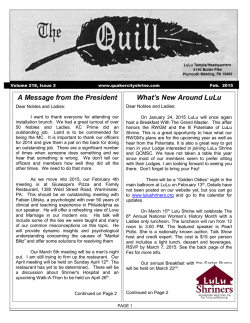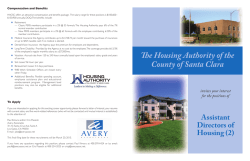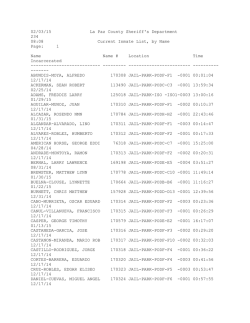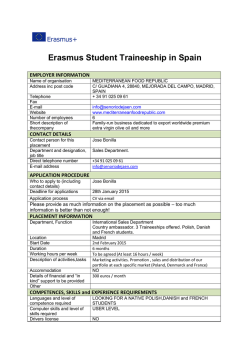
BSV Update - Amazon Web Services
BART SILICON VALLEY UPDATE Pre-Sort Standard U.S. Postage PAID Permit No. 589 San Jose, CA 1436 California Circle • Milpitas, CA 95035 Spring 2015 BART Silicon Valley – Community Update – Spring 2015 PROGRAM OVERVIEW Phase I Berryessa Extension Phase II Santa Clara Extension Service Area Extends the BART System 10 miles from the future Warms Springs Station to San Jose Extends the BART System 6 miles from the future Berryessa Station to Santa Clara Project Cost $2.3 Billion $4.7 Billion Stations • Milpitas, near the Great Mall • Alum Rock, in northeast San Jose • Berryessa, near San Jose Flea Market • Downtown San Jose, near City Hall • Diridon, near the Diridon Caltrain Station in San Jose • Santa Clara, near Santa Clara University Planned Passenger Service 2017 2025 Timeline for BART Phase II Where the Rubber Meets the Rail: Recycling Tires to Reduce Vibration T he Santa Clara Valley Transportation Authority received a $300,600 grant from CalRecycle – the State’s champion for waste reduction, recycling and reuse – for the installation of Tire Derived Aggregate (TDA) on the BART Silicon Valley Project. TDA is a method of sustainable construction in which scrap vehicle tires are transformed into a vibration-reducing material. Approximately 4,200 tons of TDA will be installed beneath the tracks in four locations along the BART Silicon Valley corridor to help reduce vibration from passing BART trains. Learn More VTA provides notification of construction activities and traffic updates through the mail and website updates. If you would like to be added to the project mailing list to receive updates or have questions, comments or concerns, please contact VTA Community Outreach at the phone number or email address provided below. TDA is an environmentally-friendly construction material, which provides a permanent second use for recycled tires. A one-foot thick layer of shredded tires will be placed beneath the track foundation, where BART R 1505-0108 VTA da aviso de las actividades de las obras y de cambios en el tráfico por medio de informes enviados por correo y publicados en el sitio Web. Si le gustaría ser agregado(a) a la lista de correo para recibir avisos, o si tiene alguna pregunta, comentario o inquietud, favor de contactar al programa de extensión a la comunidad, Community Outreach, de VTA al teléfono o al correo electrónico proporcionado a continuación. Back row: VTA staff Oxo Slayer, Nicole Franklin, Ben Glickstein and Brent Pearse. Front row: VTA staff Rachael Keish and Gail Collins and SSH staff Cassandra Manansala and Jose Mendoza. Individuals who require language translation, American Sign Language, or documents in accessible formats are requested to contact VTA Community Outreach at (408) 321-7575 / TTY (408) 321-2330. vta.org/bart Email: [email protected] rails will be installed. This engineering method has a proven track record: in 2005, the material was installed on 3,000 feet of the Vasona light rail extension Image courtesy of CalRecycle. in the City of Campbell, making VTA the first public agency in the United States to do so. Over the past 10 years the material has reduced vibrations from light rail trains as intended. Using TDA is environmentally-friendly, minimizes noise and vibration and is cost-effective for the taxpayer. To learn more about Tire Derived Aggregate, watch CalRecycle’s video here: http://bit.ly/1FwFBoC VTA in the Neighborhood Obtenga más información (408) 934-2662 • TTY: (408) 321-2330 Image courtesy of CalRecycle. facebook.com/bartsv twitter.com/bartsv epresentatives of BART Silicon Valley are out and about in the neighborhood every day, listening to neighbor’s concerns, helping to move the project forward and addressing the needs of the community during construction. A representative from the project may visit your home in order to discuss specific construction activities in your area. These representatives should always have their identification prominently displayed, which will be from VTA (Santa Clara Valley Transportation Authority) or SSH (Skanska/Shimmick/Herzog). If you have any reason to doubt that the visitor is an official project representative, ask us for our identification or call (408) 934-2662 to confirm. 880 r ye ssa Rd SAN JOSE Ber 101 Berryessa Station San Jose Int’l Airport ing edd 87 E EH Santa Clara Station Santa Clara University SANTA CLARA St lian E Ju 17 or Tayl r abu M d yR St e cKe Rd St M ara S Cl anta St Alum Rock Station San Jose State Downtown University Dirid on Station San Jose Station ht Lig VTA is now analyzing Project impacts, mitigation measures, and alternatives (4 station or no-build). During the spring/summer of 2015, VTA will conduct several community meetings on a range of topics including economic and community benefits, station features, consistency with local station area land use plans, transportation connectivity, construction methods and innovative financial strategies. rain I n spring 2015, VTA completed the construction of the sweeping steel canopy which will shade the future Berryessa BART Station boarding platform. To learn more about this unique architectural element, VTA’s Linh Hoang interviewed Claudia Guadagne, president of FMG Architects, who created the station’s design. V TA and the Federal Transit Administration have begun the environmental study for VTA’s BART Silicon Valley Phase II Extension Project. In February 2015, VTA held three scoping meetings to identify the significant issues to be addressed for the proposed six-mile, four-station extension of the BART system from the Berryessa Station in San Jose (currently under construction) to the City of Santa Clara. VTA accepted scoping comments through March 2, 2015, which focused primarily on station access and connectivity (rail transfers, bicycle and pedestrian connections to the future BART stations and transportation options to and from Mineta San Jose International Airport). Comments received during the scoping process will be used to direct a comprehensive environmental analyses and technical studies as needed. Calt PROJECT SPOTLIGHT: Berryessa Station Architecture Installation of the steel canopy above the boarding platform at the Berryessa Station. Rai l VTA’s BART Phase II Kicks Off To learn more about Phase II visit us at: www.vta.org/bart/environmentalphaseII. Watch the interview here: bit.ly/1P3vQbc “This is a very exciting time for transit,” says Guadagne. “The majority of BART stations were constructed almost 50 years ago. Now, the focus has changed to incorporate station designs into the local culture and community.” In the case of Berryessa Station, the curved canopy design is inspired by the lines of North San Jose’s creeks and hills. COMBINED SEIS/SEIR3 PROCESS CEQA NOTICE OF PREPARATION SCOPING VTA BOARD IDENTIFIES PROJECT FOR FEDERAL FUNDING DRAFT SEIS/SEIR3 FINAL SEIS/SEIR3 PROJECT APPROVAL COMMUNITY ENGAGEMENT Berryessa Station architectural canopy. JAN 2015 17 FEB 2015 MAR 2015 FEB 2016 APR 2016 MAR 2017 Innovation in Construction S ince VTA’s Berryessa Extension Project covers a large geographic area, the project team has turned to new technology to monitor construction and to improve productivity. VTA’s contractor has hired a Bay Area startup to fly unmanned aerial vehicles (UAVs) over the entire project. The UAVs, or drones, take high-resolution photographs of the project and provide real-time data to the project team. The progress photos give the contractor a comprehensive view of the project that allows them to avoid potential Image courtesy of Skycatch, Inc. Are We There Yet? D id you ever wonder why it takes so long to build an extension of the regional BART system? VTA started construction on the Berryessa Extension in April 2012, and the new stations are scheduled to open in fall 2017. So, why does it take five and a half years to build 10 miles of the system and two new BART stations? The simple answer is scale. VTA’s BART Silicon Valley Berryessa Extension Project extends BART service 10-miles into Santa Clara County. The amount of infrastructure required to build the largest capital project in the South Bay’s history is staggering. Milpitas Station on the Rise issues. Because the drones fly over the project on a regular basis, the contractor is able to track the use of materials and monitor construction progress without leaving the office. The use of drone technology improves jobsite safety, product quality, budget and schedule management, resulting in more efficient construction practices. • Excavate 700,000 cubic yards of dirt; equal to 58,000 dump trucks A fter three years of digging and working underground, the Milpitas BART Station has finally started to rise up. The concrete floor of the street level concourse gathering area, where transit riders will enter the station and purchase tickets, has been poured. Commuters travelling along Montague Expressway near the Great Mall will see the installation of steel start to form the roof and walls of the future BART station building. Conceptual rendering of the Milpitas BART Station featuring a pedestrian bridge to the Montague Light Rail Station. • Pour 280,000 cubic yards of concrete; equal to 28,000 concrete trucks Construction is underway on various improvements to provide pedestrians, cyclists and transit riders all have easy access to the station. Structural columns have been built making way for the construction of a pedestrian bridge that will provide a convenient and direct connection between the future BART station and VTA’s Montague Light Rail Station. The installation of underground utilities is complete and the foundation construction for an indoor bike storage facility is underway. The facility will have 180 secure bike parking spaces inside the building monitored by BikeLink™. To see the construction progress at the Milpitas Station visit: www.vta.org/bart/ camviews. • 130 million pounds of ballast or rock to support the BART tracks Where We Stand: What Needs to be Done: Consider these facts about what is required to construct the Berryessa Extension: • Construct bridges and two and half miles of trenches for BART trains to pass under or over 13 major intersections (grade separations) • One mile of elevated guideway • 20 miles of tracks Dirt Excavated 88% Concrete Poured 67% Structural columns for the future pedestrian bridge between the Milpitas BART Station and the Montague Light Rail Station under construction. Milpitas Station steel structure rising from the ground (April 2015). Berryessa Extension Project Current and Upcoming Construction Activities End Warm Springs Extension Begin Berryessa Extension Legend sion Mis BART Tracks Future Station VTA Light Rail Alternative Routes Blvd E Warren Ave 880 Intersection Work Mission Boulevard The newly widened Mission Blvd., from two to three lanes in both directions between I-880 and Warm Springs Blvd. Mission Blvd. now features newly constructed on-and-off ramps from Kato Rd. 680 Mission Blvd. fue recientemente ampliado de dos a tres carriles en ambas direcciones entre la carretera I-880 y Warm Springs Blvd. Mission Blvd. ofrece ahora nuevas rampas de entrada y salida en Kato Rd. Kato Rd Expect reduced lanes, multiple traffic shifts and periodic weekend closures through fall 2015 to support trench and bridge construction, and utility relocations. Kato Rd. is the designated detour route during road closures. Warm Springs Blvd Dixon Landing Road FREMONT Espere reducción de carriles, múltiples cambios en el tráfico y cierres periódicos los fines de semana hasta finales del otoño de 2015 para asistir las obras de construcción de las zanjas y el puente, y para la reubicación de servicios públicos. Kato Rd. es la ruta de desviación designada durante el cierre de la calle. Scott Creek Rd Kato Rd N Milp itas B lvd Dixon Landing Rd MILPITAS cC bel St a rt hy B lvd Trade Zone Boulevard Capitol Avenue NA M Periodic lane reductions and traffic shifts will occur through fall 2015 to N relocate utilities and construct a street-level bridge and trench for BART to pass underneath the roadway. Habrá reducciones periódicas de los carriles y cambios en el flujo del tránsito hasta finales del otoño de 2015 con el fin de reubicar los servicios públicos, construir un puente a nivel de la calle y una zanja para que BART pueda pasar por debajo de la calzada. Traffic will be shifted in stages and lane capacities reduced through summer 2015 in order to relocate utilities, build a street-level bridge and trench for BART to pass underneath the roadway. Calave ras Blvd Se cambiará el flujo del tránsito por etapas y se reducirá la capacidad de carriles hasta finales del verano de 2015 con el fin de reubicar los servicios públicos, construir un puente a nivel de la calle y una zanja para que BART pueda pasar por debajo de la calzada. S Abel St 237 A VT s Blv IL RA ilpita T GH LI SM Great Mall d hy B lvd a rt M N dy A ve ve ol A pit Ca La intersección de Sierra Rd. y Lundy Ave. estará cerrada temporalmente al acceso púbico (automóviles y peatones) hasta el otoño de 2015. Por favor siga la desviación oficial en Flickinger Ave., así como los señalamientos de desviación adicionales colocados en el área. A partir de la primavera, algunos horarios de trabajo se extenderán entre las 7 p.m. y las 10 p.m., y tanto el ruido como la iluminación serán monitoreados cuidadosamente. Berryessa Road Milpitas Station T Zon rade eB lvd cC The intersection of Sierra Rd. and Lundy Ave. is temporarily closed to public access (automobiles and pedestrians) until fall 2015. Please follow official detour on Flickinger Ave. and additional detour signage in the area. Starting in the spring, some work activities will be extended to the hours between 7 p.m. and 10 p.m. with noise and lighting being monitored closely. Mo n Exp tague wy McC a ndle ss D r Lundy Avenue and Sierra Road Construction of the elevated bridge structure that will span across Berryessa Rd. is underway. Expect lane reductions and periodic night time road closures during fall 2015. Lun La construcción del puente elevado, el cual cruzará sobre Berryessa Road, está en progreso. Anticipe una reducción de carriles y cierres nocturnos periódicos de la calle durante el otoño de 2015. d rR tte e ost H Flick ve hy A inge Murp r Ave Lund e y Av rra Sie Rd B E St Hedding End Berryessa Extension Ave St kson 101 E Taylor N Jac B d ury R Mab d sa R es erry N King Rd Berryessa Station d aR ess y err , Innovation in Construction S ince VTA’s Berryessa Extension Project covers a large geographic area, the project team has turned to new technology to monitor construction and to improve productivity. VTA’s contractor has hired a Bay Area startup to fly unmanned aerial vehicles (UAVs) over the entire project. The UAVs, or drones, take high-resolution photographs of the project and provide real-time data to the project team. The progress photos give the contractor a comprehensive view of the project that allows them to avoid potential Image courtesy of Skycatch, Inc. Are We There Yet? D id you ever wonder why it takes so long to build an extension of the regional BART system? VTA started construction on the Berryessa Extension in April 2012, and the new stations are scheduled to open in fall 2017. So, why does it take five and a half years to build 10 miles of the system and two new BART stations? The simple answer is scale. VTA’s BART Silicon Valley Berryessa Extension Project extends BART service 10-miles into Santa Clara County. The amount of infrastructure required to build the largest capital project in the South Bay’s history is staggering. Milpitas Station on the Rise issues. Because the drones fly over the project on a regular basis, the contractor is able to track the use of materials and monitor construction progress without leaving the office. The use of drone technology improves jobsite safety, product quality, budget and schedule management, resulting in more efficient construction practices. • Excavate 700,000 cubic yards of dirt; equal to 58,000 dump trucks A fter three years of digging and working underground, the Milpitas BART Station has finally started to rise up. The concrete floor of the street level concourse gathering area, where transit riders will enter the station and purchase tickets, has been poured. Commuters travelling along Montague Expressway near the Great Mall will see the installation of steel start to form the roof and walls of the future BART station building. Conceptual rendering of the Milpitas BART Station featuring a pedestrian bridge to the Montague Light Rail Station. • Pour 280,000 cubic yards of concrete; equal to 28,000 concrete trucks Construction is underway on various improvements to provide pedestrians, cyclists and transit riders all have easy access to the station. Structural columns have been built making way for the construction of a pedestrian bridge that will provide a convenient and direct connection between the future BART station and VTA’s Montague Light Rail Station. The installation of underground utilities is complete and the foundation construction for an indoor bike storage facility is underway. The facility will have 180 secure bike parking spaces inside the building monitored by BikeLink™. To see the construction progress at the Milpitas Station visit: www.vta.org/bart/ camviews. • 130 million pounds of ballast or rock to support the BART tracks Where We Stand: What Needs to be Done: Consider these facts about what is required to construct the Berryessa Extension: • Construct bridges and two and half miles of trenches for BART trains to pass under or over 13 major intersections (grade separations) • One mile of elevated guideway • 20 miles of tracks Dirt Excavated 88% Concrete Poured 67% Structural columns for the future pedestrian bridge between the Milpitas BART Station and the Montague Light Rail Station under construction. Milpitas Station steel structure rising from the ground (April 2015). 880 r ye ssa Rd SAN JOSE Ber 101 Berryessa Station San Jose Int’l Airport ing edd 87 E EH Santa Clara Station Santa Clara University SANTA CLARA St lian E Ju 17 or Tayl r abu M d yR St e cKe Rd St M ara S Cl anta St Alum Rock Station San Jose State Downtown University Dirid on Station San Jose Station ht Lig VTA is now analyzing Project impacts, mitigation measures, and alternatives (4 station or no-build). During the spring/summer of 2015, VTA will conduct several community meetings on a range of topics including economic and community benefits, station features, consistency with local station area land use plans, transportation connectivity, construction methods and innovative financial strategies. rain I n spring 2015, VTA completed the construction of the sweeping steel canopy which will shade the future Berryessa BART Station boarding platform. To learn more about this unique architectural element, VTA’s Linh Hoang interviewed Claudia Guadagne, president of FMG Architects, who created the station’s design. V TA and the Federal Transit Administration have begun the environmental study for VTA’s BART Silicon Valley Phase II Extension Project. In February 2015, VTA held three scoping meetings to identify the significant issues to be addressed for the proposed six-mile, four-station extension of the BART system from the Berryessa Station in San Jose (currently under construction) to the City of Santa Clara. VTA accepted scoping comments through March 2, 2015, which focused primarily on station access and connectivity (rail transfers, bicycle and pedestrian connections to the future BART stations and transportation options to and from Mineta San Jose International Airport). Comments received during the scoping process will be used to direct a comprehensive environmental analyses and technical studies as needed. Calt PROJECT SPOTLIGHT: Berryessa Station Architecture Installation of the steel canopy above the boarding platform at the Berryessa Station. Rai l VTA’s BART Phase II Kicks Off To learn more about Phase II visit us at: www.vta.org/bart/environmentalphaseII. Watch the interview here: bit.ly/1P3vQbc “This is a very exciting time for transit,” says Guadagne. “The majority of BART stations were constructed almost 50 years ago. Now, the focus has changed to incorporate station designs into the local culture and community.” In the case of Berryessa Station, the curved canopy design is inspired by the lines of North San Jose’s creeks and hills. COMBINED SEIS/SEIR3 PROCESS CEQA NOTICE OF PREPARATION SCOPING VTA BOARD IDENTIFIES PROJECT FOR FEDERAL FUNDING DRAFT SEIS/SEIR3 FINAL SEIS/SEIR3 PROJECT APPROVAL COMMUNITY ENGAGEMENT Berryessa Station architectural canopy. JAN 2015 17 FEB 2015 MAR 2015 FEB 2016 APR 2016 MAR 2017 BART SILICON VALLEY UPDATE Pre-Sort Standard U.S. Postage PAID Permit No. 589 San Jose, CA 1436 California Circle • Milpitas, CA 95035 Spring 2015 BART Silicon Valley – Community Update – Spring 2015 PROGRAM OVERVIEW Phase I Berryessa Extension Phase II Santa Clara Extension Service Area Extends the BART System 10 miles from the future Warms Springs Station to San Jose Extends the BART System 6 miles from the future Berryessa Station to Santa Clara Project Cost $2.3 Billion $4.7 Billion Stations • Milpitas, near the Great Mall • Alum Rock, in northeast San Jose • Berryessa, near San Jose Flea Market • Downtown San Jose, near City Hall • Diridon, near the Diridon Caltrain Station in San Jose • Santa Clara, near Santa Clara University Planned Passenger Service 2017 2025 Timeline for BART Phase II Where the Rubber Meets the Rail: Recycling Tires to Reduce Vibration T he Santa Clara Valley Transportation Authority received a $300,600 grant from CalRecycle – the State’s champion for waste reduction, recycling and reuse – for the installation of Tire Derived Aggregate (TDA) on the BART Silicon Valley Project. TDA is a method of sustainable construction in which scrap vehicle tires are transformed into a vibration-reducing material. Approximately 4,200 tons of TDA will be installed beneath the tracks in four locations along the BART Silicon Valley corridor to help reduce vibration from passing BART trains. Learn More VTA provides notification of construction activities and traffic updates through the mail and website updates. If you would like to be added to the project mailing list to receive updates or have questions, comments or concerns, please contact VTA Community Outreach at the phone number or email address provided below. TDA is an environmentally-friendly construction material, which provides a permanent second use for recycled tires. A one-foot thick layer of shredded tires will be placed beneath the track foundation, where BART R 1505-0108 VTA da aviso de las actividades de las obras y de cambios en el tráfico por medio de informes enviados por correo y publicados en el sitio Web. Si le gustaría ser agregado(a) a la lista de correo para recibir avisos, o si tiene alguna pregunta, comentario o inquietud, favor de contactar al programa de extensión a la comunidad, Community Outreach, de VTA al teléfono o al correo electrónico proporcionado a continuación. Back row: VTA staff Oxo Slayer, Nicole Franklin, Ben Glickstein and Brent Pearse. Front row: VTA staff Rachael Keish and Gail Collins and SSH staff Cassandra Manansala and Jose Mendoza. Individuals who require language translation, American Sign Language, or documents in accessible formats are requested to contact VTA Community Outreach at (408) 321-7575 / TTY (408) 321-2330. vta.org/bart Email: [email protected] rails will be installed. This engineering method has a proven track record: in 2005, the material was installed on 3,000 feet of the Vasona light rail extension Image courtesy of CalRecycle. in the City of Campbell, making VTA the first public agency in the United States to do so. Over the past 10 years the material has reduced vibrations from light rail trains as intended. Using TDA is environmentally-friendly, minimizes noise and vibration and is cost-effective for the taxpayer. To learn more about Tire Derived Aggregate, watch CalRecycle’s video here: http://bit.ly/1FwFBoC VTA in the Neighborhood Obtenga más información (408) 934-2662 • TTY: (408) 321-2330 Image courtesy of CalRecycle. facebook.com/bartsv twitter.com/bartsv epresentatives of BART Silicon Valley are out and about in the neighborhood every day, listening to neighbor’s concerns, helping to move the project forward and addressing the needs of the community during construction. A representative from the project may visit your home in order to discuss specific construction activities in your area. These representatives should always have their identification prominently displayed, which will be from VTA (Santa Clara Valley Transportation Authority) or SSH (Skanska/Shimmick/Herzog). If you have any reason to doubt that the visitor is an official project representative, ask us for our identification or call (408) 934-2662 to confirm.
© Copyright 2025




